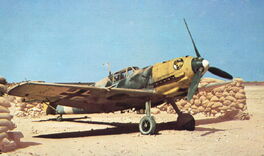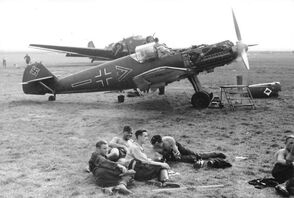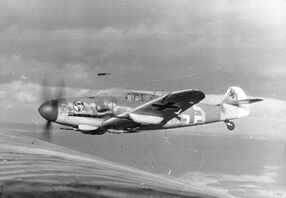The Messerschmitt Bf 109 was a single-seat fighter aircraft used by Germany and many of her allies during World War II.
Description[]
The first production model of the series was the Bf 109B-1 with some pre-production A models being produced before.
The Bf-109B-1 was normally powered by a single 536 kW Junkers Jumo 210D engine, this allowed the fighter to travel at a maximum speed of 560 km/h at a range of 660 km. The fighter had a service ceiling of 10,500 meters, but the oil-cooled design left the engine far more vulnerable to damage than the air-cooled designs of later fighters.
The Bf 109 was 8.64 meters long and had a wingspan of 9.87 meters. Its height meanwhile was 2.50 meters and its combat weight was 2,665 kilograms. The armament of the Bf 109B-1 consisted solely of three MG 17 machine guns; two of which were mounted in the nose while the third was mounted in the propeller hub. The armaments, engines, and armor varied by model type and were changed to suit mission requirements as the war progressed.[1][2] The Bf 109 was the mainstay of the Luftwaffe through the war, with Germany never being able to produce the Fw 190 in sufficient numbers to replace it. The Fw 190 though, was by most accounts, a superior aircraft.
Variants[]
The first variant of the long series of Bf 109s was the C-1, C-2, and C-3 models which were given an additional MG 17 and an improved Junkers Jumo engine. The additional machine gun was then grouped along with the machine gun previously in the propeller hub to the wings.[3] The C-1 was also the first model in the series to have direct fuel injection. The C-2 was given an experimental armament of five machine guns while the C-3 was given two 20 mm autocannons and two machine guns.
In reality though, the C models were more test models than actual production aircraft. The D series was only used by the Luftwaffe just prior to the start of the war and during early combat in Poland. The only model, the D-1 was fundamentally similar to previous examples minus several modifications to the design. The next minor series however, the "Emil" series was far more revolutionary than its counterparts. As such, the E series was the most produced during the war and saw the most service.
The first of these models were the E-1 and E-1/B models. The E-1 had many minor improvements made since the previous testing on the C and D series. Furthermore, it had an offensive armament that consisted of only four 7.92 mm machine guns. Its sub-variant, the E-1/B was simply a fighter bomber conversion. Following came the E-3, which brought about the addition of further armor plating, and the addition of two 20 mm MG FF cannons as well as the standard two MGs. By this time, the Daimler Benz DB-601 engine was also added to the Bf 109.[4] Although some examples of the E-3 only had one autocannon that fired through the propeller hub instead of the wings.

A Bf 109E-7 in North Africa.
The E-4 model which later replaced the E-3 and was generally the most common type seen in conflicts such as in the Battle of Britain had the same two autocannon, two machine gun armament as seen on the regular E-3 but it had a redesigned cockpit that was more of a "square" shape and also had redesigned autocannons to suit a new type of explosive ammunition that was more effective than standard ammunition for the MG FFs. Further armor plating was also added to the air frame. This model, being as successful as it was, had several sub-variants for other types of combat service. The first of these, E-4/B was the traditional fighter bomber conversion while the E-4/Trop model was a desert warfare conversion that was built to withstand the immense pressures of fighting in North Africa. Following came the E-4/N with the new DB-601N engine. Also produced was the E-4/BN which was the fighter bomber conversion of the E-4/N.
Also in the E series were the E-5, E-9, E-6 reconnaissance platforms that featured a reduced armament in compensation for additional camera equipment and E-7 and E-8 with the Bf 109T being an aircraft carrier model designed for use with the Graf Zeppelin. The E-7 was the first to implement 300 liter drop tanks while the E-8 once again had an improved DB 601 engine. The E-7 also had a the revised armament of a single autocannon firing from the propeller hub, two MG 17s firing from the nose, and two more MG 17s firing from the wings.
The next major sub-series of the 109 were the F models. These mainly featured aerodynamic improvements and carried updated DB 601 power plants. Most of the cabin and air frame were redesigned to be more combat effective. In total, there were six variations of the F model not including the F2/Trop version or the F-4/R1 special variants. The first of the F models was the F-1 armed with a single MG FF and two machine guns.
Also significant about the F models was that they were the first to use "field kits" for weapon and aircraft customization for mission specific purposes. The F-2 had a standard armament of a single MG 151 15 mm autocannon and two machine guns. The F-3 was identical to the F-2 except for an improved power plant and the F-4 as given a single 20 mm autocannon once more and two machine guns. The F-5 was merely a reconnaissance platform.
The next sub-series of the Bf 109 were the G or "Gustav" models. These were largely improved and had by far the most sub-variations. The first of these models, the G-1's most notable feature was the introduction of the new and improved Daimler Benz 605 Engine. Following came the G-2, a model designed for low altitude operations as the cabin was un-pressurized. Its sub-variants, were the G-2/R2, a reconnaissance model, and the G-2/Trop.
The G-3 and G-4 models had emergency power boost functions added along with the return of a pressurized cabin. The G-4 also had the G-4/R2, G-4/R3, G-4/trop, and G-4y sub-variants. The G-5 meanwhile had corrected the key problems encountered with the initial change to a new engine. The fact of the matter was that the German high command had been pushing for faster engines that could compete with faster allies aircraft like the P-51 Mustang.

A Messerschmitt Bf 109 by its crew, part of Jagdgeschwader 53
This drive had made the designs put out too early and as a result not all of the main problems had been fixed. The G-6 model was the most prevalent design made during the war and as such had the most sub-variants. The first variants, were the G-6/R2, G-6/R3, G-6/R6. The R3 being a reconnaissance platform, the R6 having a further two 20 mm autocannons, and the R2 having a field kit designed for fighter bomber operations.
Also produced were the G-6/trop, G-6/AS high altitude hunter, and the G-6/N nightfighter. The G-8 model was designed as a further improved reconnaissance platform at the cost of most of the armor protection that had been added over the series of improvements. Next produced was the G-10 light fighter though it was later converted into a heavy fighter through the R5 model's 20 mm autocannons and the U4's 30 mm autocannon. For training purposes, the two seater G-12 examples was built with its R3 sub-variant model featuring 300 liter drop tanks. The final model in G series was the G-14 which was fundamentally a lighter conversion of the G-6 with most of its sub-variants being converted to the air frame.
The H series although technically being used in 1944, was limited to say the least. Though most of the variants to be were canceled. The last sub-series of the Bf 109 were the K models which were based upon the G-10 model. The K series was designed to compensate for almost all mission scenarios as resupplying air units with various different field kits and special variants eventually proved problematic.[5] The first models, the K-2 and K-4 proved to be quite fast and were well liked. The K-4 though was pressurized unlike the K-2. The final model, the K-6 had two 12.7 mm machine guns and two 3 0mm autocannons in under-wing mounts.[6]
History[]
Prototypes[]
The Bf 109 was conceived in the summer of 1934, when the German Air Ministry (RLM) issued a requirement for a single seat interceptor fighter monoplane to replace the obsolescent Heinkel He 51 and Arado Ar 68 biplanes then in service.[7] The issuing of the requirement was partly due to a disagreement between Obstlt Wilhelm Wimmer, an influential official in the RLM technical department, and Willi Messerschmitt & Rakan Kokothaki, directors of Beyerische Flegzeugwerke (BFW), during which Wimmer complained about BFW concentrating on producing aircraft for foreign countries. Messerschmitt responded by pointing out that, due to the lack of orders from Wimmer's department, BFW had been forced to seek outside orders in order for the company to survive.[8] [N 1] Four manufacturers were subsequently awarded development contracts; Arado for the Ar 80, Beyerische Flegzeugwerke for the Bf 109, Ernst Heinkel A.G. for the He112 and Focke-Wulf for the Fw 159. The Focke-Wulf used the new and relatively untried Jumo 210A engine producing 454 kW, while the others used the more reliable Rolls Royce Kestrel V rated at 518 kW.

A Bf 109 flying over North Africa in 1943.
The Bf109V1, bearing factory number 758 and civil registration D-IABI, was completed in the summer of 1935.[7] The Bf 109V1 made its first flight in the hands of Hans-Dietrich Knoetzsch at Augsburg-Haunstetten on May 28, with further test flights before the aircraft was flown to the experimental test centre at at Rechlin on October 15. However, following severe damage caused when the aircraft bounced on landing, D-IABI was returned to Augsburg for repair, before being sent to Travemunde for evaluation, as Rechlin was overburdened with development work. Evaluation was also carried out on prototype V2 (WNr 759/D-IILU)[N 2], which was first flown on 12 December 1935.[11]
In early 1936 Dr Ing Hermann Wurster replaced Knoetzsch as chief test pilot, collecting D-IABI on 17 July 1936 for spin and stall tests, as well as trials for weapon installation, which took place from August 1935 until 13 January 1937, when it was grounded. The aircraft was eventually scrapped, despite the crash of D-IILU/D-IDUE little more than three months after it's first flight. The loss of both D-IABI and D-IILU/D-IDUE meant the third prototype (Wnr 760/D-IOQY) was the only example available for testing when it made its first flight on 8 April 1936. D-IOQY was the first Bf-109 to carry armament, although difficulties with the engine mounted cannon restricted this to a pair of rifle calibre machine guns in the cowling. directly above the 500 hp Jumo 210C engine.[12]
D-IOQY was transferred to Travemunde for an extensive test programme, which led to the deletion of the So-3 vertical bomb cell located behind the pilot's seat[N 3], as the small bombs could only be released from low altitude due to a lack of SC 10 electrical fuses.[12]
Combat[]
Following removal of the So-3, and the first flight of the Bf-109V4 - D-IALY - on 23 September, D-IOQY was crated up and sent to Spain for operational evaluation as part of the Spanish Civil War.[12] The V4 was also shipped on 30 November after serving as prototype for the B series at Travemunde. At least 20 Bf-109As went to Spain, including some test examples.[14]
Serving with the Tablada-based Jagdgruppe 88 of the Condor Legion, V3, V4, V5 (D-IEKS/D-IIGO) and V6 (D-IHHB) were joined by the first examples of the Bf-109B to be sent to Spain.[15] It was while the 109B was operating with the first and second Stafflen in Spain that rumors regarding the type's structural weakness began circulating, giving the impression that the type was liable to disintegrate when performing high stress manoeurves. [N 4]Towards the end of the civil war, a few Bf 109Es were passed to Spain, gaining the nickname 'Tripala' due to their three bladed propellers.
By the time war was declared on September 3, 1939, following the invasion of Poland, the Bf-109E-1 was the standard fighter in Luftwaffe service, although a number of D models remained in service.[16] As the series advanced, the Bf 109 became ever more effective in combat until it had reached its peak. Although the Focke Wulf Fw 190 is generally considered a better aircraft, it simply was not produced in the numbers needed to fully replace the 109 and instead served more to compliment it. In total, around 33,000 bf 109s were created by the end of the war serving in all theaters of operations that Germany took part in with some even being sent to Japan as test aircraft.
Notes[]
- ↑ This may have been due to distrust of Messerschmitt's designs within the RLM, following crashes involving examples of the M29 Light aircraft and the M20 passenger plane.[9]
- ↑ Also known as D-IDUE.[10]
- ↑ Containing five 22lb (10kg) bombs, the S0-3 was intended to provide a means of providing an offensive capability without incurring the drag penalty of an external bomb rack.[13]
- ↑ This was due to exaggerated reports about a damaged 109B losing it's tail while in a high speed dive.[7]
References[]
- ↑ Robert Jackson, Jim Winchester. Dogfight: Military Aircraft Compared and Contrasted. Amber Books Ltd (2006), ISBN 978 0 7607 8169 2
- ↑ Green, William and Gordon Swanborough. Complete Book of Fighters. Salamander Books. 2001. ISBN 1-84065-269-1
- ↑ http://www.wwiivehicles.com/germany/aircraft/fighters/messerschmitt-bf-109-a-d.asp
- ↑ http://www.museumofflight.org/aircraft/messerschmitt-bf-109e-3
- ↑ http://acepilots.com/german/bf109.html
- ↑ http://www.militaryfactory.com/aircraft/detail.asp?aircraft_id=83
- ↑ 7.0 7.1 7.2 Green, William. Famous Fighters of the Second World War. Purnell Book Services. 1975.
- ↑ Kay, Antony L and J R Smith. German Aircraft of the Second World War. Putnam Aeronautical Books. 2002. ISBN 0 85177 920 4
- ↑ A&L Bf 109 Pages 7-8
- ↑ Nowarra, Heinz.(1989),
- ↑ Scutts, Jerry. Combat Legend Messerchmitt Bf 109. Airlife Books (2002), ISBN 1 84037 364 4 (2002), Pages 6-7.
- ↑ 12.0 12.1 12.2 Scutts, Jerry. Page 7.
- ↑ Scutts, Jerry. (2002), Page 89.
- ↑ Scutts, Jerry. (2002), Page 8.
- ↑ Scutts, Jerry. (2002), Page 21.
- ↑ Nowarra, Heinz 1989. Page 55
| |||||||||||||||||||||||||||||||||||||||||
| This article has an image archive! Click the category Messerschmitt Bf 109 to see it! |
